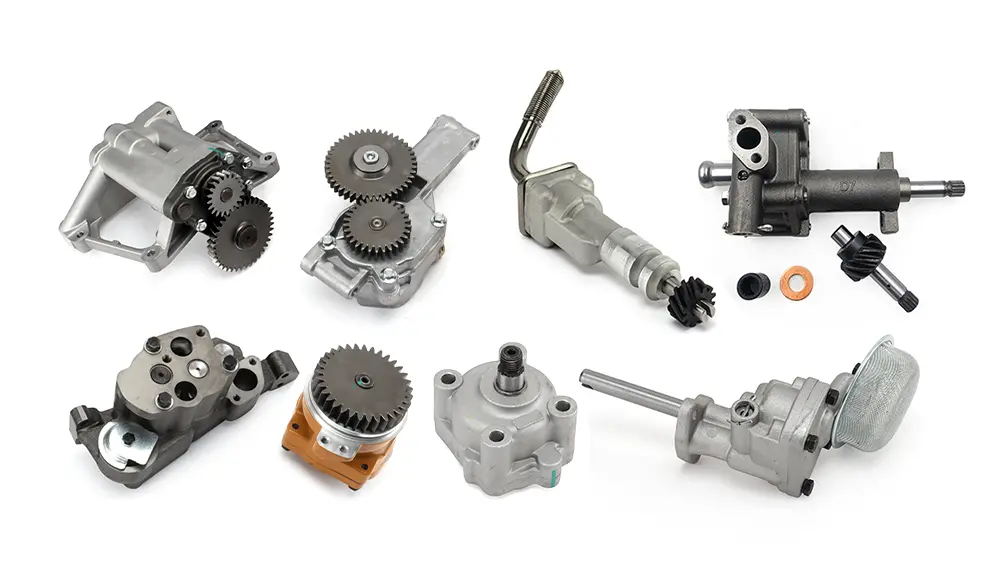Working principle of the oil pump
Function of oil pump: It extracts and pressurizes engine oil and pushes it to various friction parts of the engine (such as crankshaft, camshaft, bearings, etc.) to achieve lubrication and cooling
Common types:
Gear pump: It forms oil suction and oil pressure through the meshing of two gears.
Vane pump: The blades expand and absorb oil, and compress and push oil as the rotor rotates
Workflow:
⬇️Oil is sucked from the oil pan and filtered to prevent large particles from entering;
⬇️After the oil pump is pressurized, the oil flows through the oil filter.
⬇️It is distributed to bearings, pistons, cylinder liners, etc.
⬇️The oil flows back to the oil pan to form a circulation system.

Common signs of oil pump failure
- Low oil pressure
The most typical signal: the pressure light on the dashboard is on, or the pressure gauge is low. - Engine abnormal noise (knocking, metal impact sound)
Insufficient lubrication causes knocking sounds from bearings, hydraulic tappets, or valve mechanisms - Oil pump body noise
Internal gear or blade wear causes clicking, whistling, and humming sounds - Engine overheating or temperature rise
Lack of oil causes increased friction, poor heat dissipation, and temperature rise - Power loss/difficult starting
Insufficient oil pressure affects the lubrication of key components, resulting in reduced engine power and increased starting resistance
Causes of oil pump failure
- Lack of oil or poor quality
Low oil volume or long-term unchanging oil volume leads to poor lubrication and internal wear of the oil pump. - Oil contamination and carbon deposition
Impurities enter the oil circuit and cause filter blockage, affecting the oil pump suction. - Wear/fatigue of internal parts
Gears, blades, seals, etc., are aged and failed due to long-term high load - Pressure valve failure or spring failure
Improper adjustment leads to abnormal pressure (too high or too low). - Clogged oil suction pipe or filter
Leading to pump suction, cavitation, noise, and efficiency reduction - Installation problems
Improper assembly, clearance errors, coupling eccentricity, etc., will shorten the life. - Overheating of the engine and abnormal operating conditions
Oil viscosity decreases in high-temperature environments, accelerating component wear.
What should I do?
If these signs appear, the best option is to check and repair the faulty oil pump in time to minimize losses.
🛑 Emergency treatment
A: Stop the car immediately and turn off the engine to prevent serious damage to the engine due to failure of the lubrication system.
B: Check the oil status: use a dipstick to measure the oil level, observe the oil color and viscosity, and check for signs of leakage or burning oil.
🔧 Diagnosis and repair steps
| Steps | Content |
| 1. Instrument confirmation | Use a professional pressure gauge to determine the oil pressure range. |
| 2. Disassemble and inspect components | Check whether the oil pump body, filter screen, and oil suction pipe are blocked or damaged. |
| 3. Replace components | Replace components that are severely worn, have pressure valve failures, or are leaking oil. |
| 4. Reassemble | Strictly follow standard operations to ensure assembly clearance and calibrate couplings. |
📅 Preventive maintenance measures
Regularly replace the engine oil and filter according to the manufacturer’s recommendations.
Avoid long-term high-speed operation to reduce oil temperature surges.
Regularly check the status of the oil pan and filter, and clean up the sediment in time.
Use high-quality oil pump and filter components, and strictly follow the professional installation process.
Summary
Although the oil pump is a small part of the engine, it is the core of engine lubrication. Once it fails, it will affect the service life and performance of the engine.
“Prevention is better than repair.” – Insisting on maintenance, paying attention to oil pressure, timely replacement, and replacing high-quality spare parts are the best strategies to ensure efficient and stable operation of the engine.

